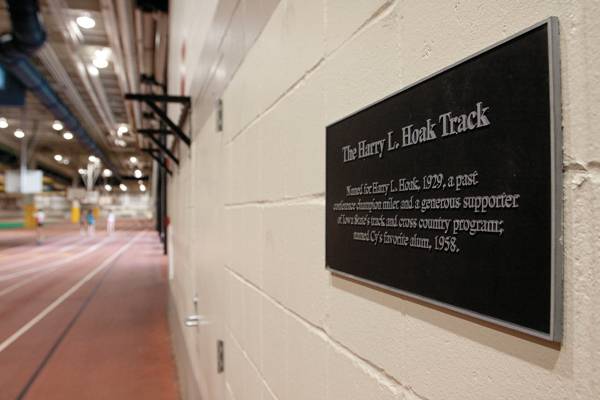TRACK: Hoak’s legacy

The track on the main level of the Lied Recreation Athletic Center is named after Harry L. Hoak. Hoak is an ISU alumnus and was a conference champion for the Cyclones in the 880-yard run and the mile in 1929. Photo: Tim Reuter/Iowa State Daily
April 13, 2010
Each Cyclone football player and most of the thousands of Cyclone football fans know who Jack Trice was. His story has been told and retold about his life and his death on the football field. After a multi-million-dollar makeover, Jack Trice Stadium is a fine house for the ISU football team.
The same cannot be said for the story of the Cyclones’ track facility.
Harry Hoak Track is considered one of the finest indoor track and field facilities in the Big 12. The facility is home to dozens of track and field events for the Iowa State men’s and women’s track teams, and many more ISU students use the track on the east side of the Lied Recreation Athletic Center. But very few people know who Harry Hoak was.
Not even all the track and field athletes know who he was.
“I know that the track is named after him, but I don’t know anything about him besides that,” said senior distance runner Lisa Koll, a nine-time All-American and a constantly emerging part of Iowa State’s track history.
And the same goes for those on the field.
“I’m not sure who he is,” said first-year throws coach Grant Wall.
Harry Hoak was a past track athlete at Iowa State that earned conference championship honors in the 880-yard run and the one-mile run in 1929. Despite these accomplishments and having Iowa State’s state-of-the-art indoor track bearing his name, he is not a member of the Iowa State Athletic Hall of Fame. May will mark the 20th anniversary of the track being named after Hoak.
“Maybe he should be in the hall of fame,” coach Corey Ihmels said. “Maybe that’s something that we should do because nobody knows that much about him.”
“We’re one of those obscure sports, and the kids on our team know the people that are here walking around here,” Ihmels said. “Everybody knows something that’s as well publicized as Jack Trice Stadium and his story, but we don’t go to Jack Trice Stadium. We go to the rec — we go to Harry Hoak Track.”
“I didn’t know that or much history of the track,” Koll said. “I knew [ISU] had a rich history in track, especially in distance running. It was stressed to me coming here that maybe I could bring back a resurgence of a great program and that to be a part of that would be really exciting.”
A large part of that rich history was led by former ISU track and field coach Bill Bergan, who took over the track and field and cross country programs in 1976. Bergan inherited a program that had placed last 21 of the last 25 years in the Big 8 Conference.
Iowa State had won only eight track and field or cross country conference championships in the 66 years before his arrival.
In his fourth year as coach, Bergan led the team to a Big 8 Conference title. He became a member of the hall of fame, and last year, the Cyclones hosted the Bill Bergan Invitational in his honor.
But Bergan knows who Harry Hoak was.
“There were probably athletes that were more accomplished than Harry was, but he was a great man,” Bergan said. “He was a hard worker, very generous and was always appreciative of all the success that came his way.”
After his career at Iowa State ended, Hoak graduated with a civil engineering degree and began his own construction company in Des Moines. His hard work as an athlete transferred to entrepreneurial success.
Remaining loyal to his former team, Hoak donated $35,000 to the track and field and cross country programs that allowed Harry Hoak Crossing to be built at Iowa State’s current cross country course.
Bergan said Hoak also donated about $100,000 to the athletic program that paved the way for the indoor track facility to be built and named in his honor in 1990. Hoak died in 1997, but his name remains a legacy of ISU athletics.
Even if not everyone remembers it.
“I think you have to be proud of who came before you, but all that stuff just kind of fades away,” Ihmels said.
“It was important to me to represent the university,” Ihmels said on his prestigious athletic career as a Cyclone.
“I think Iowa State is a place that you come to for the right reasons. It’s not going to have all the facilities that all the bigger schools have, but it’s a place that you come to love and respect, and that’s just the type of place that Iowa State is.”






